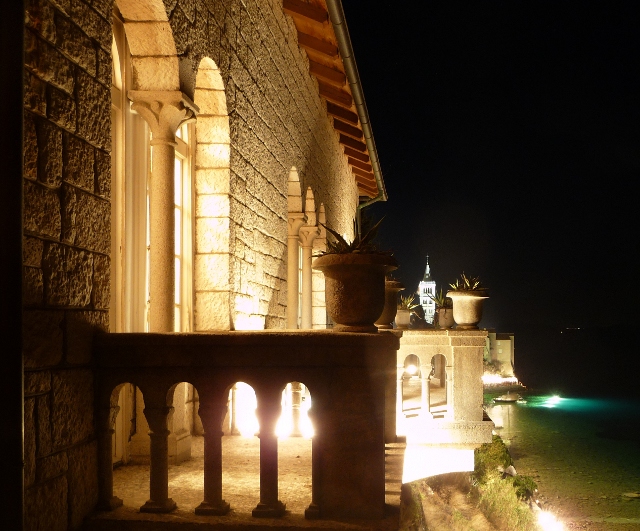Rab’s reputed to be the most beautiful of all the Croatian islands. That’s a tall order to live up to. The eastern shore, facing the mainland and bracing itself against the Bura wind over the Velebit mountains, is almost as sparse as Pag had been, but the western side was much lusher as we wound our way up from the southern tip, where the ferry lands, towards Rab town.
It turned out that for once, timing had fallen on our side – we’d arrived at the start of the annual Rabska Fjera, a three day celebration of the town and island’s medieval heritage. We found some space at the town’s sprawling campsite, and wandered in around the water’s edge. Various small craft stalls seemed to be in the early throes of setting up (one of which provided a temporary home for the large half-carved wooden bear which we’d shared the ferry with, as it lay in a trailer), but little else seemed to be happening. A little more digging found that the only schedule for the day was a 9pm welcome show. OK, if that’s the case, we’ll familiarise ourself with the town, then wander back and chill out for a bit, and return later.
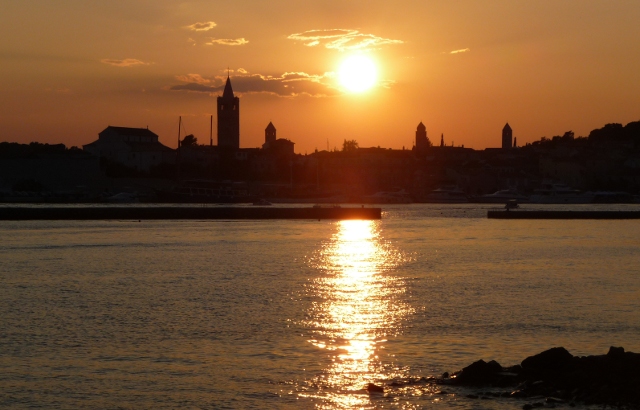 The old town sits on a long, thin outcrop forming one side of the main harbour. It rises up sharply, with the far end of the ridge housing a neat row of old churches above a small park, celebrating the local saint, St Marin – founder of the principality of San Marino.
The old town sits on a long, thin outcrop forming one side of the main harbour. It rises up sharply, with the far end of the ridge housing a neat row of old churches above a small park, celebrating the local saint, St Marin – founder of the principality of San Marino. 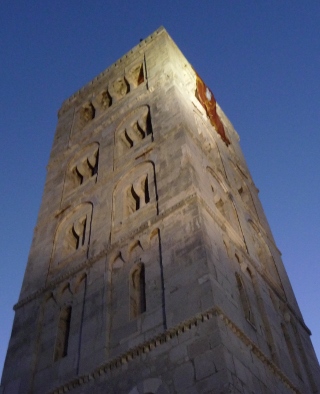 Further along the ridge, towards the rest of the island, a few more churches mingle with small palaces and a few civic buildings, with narrow winding streets of houses tumbling towards the harbour below, before the fortifications mark the change from old town to new. On the opposite side, cliffs fall down to a sea-front walkway facing onto a broad bay opposite a forested peninsula. Next to superyachts, taxi-boats sit in the harbour, waiting to take people along to their hotels, over to islands or the peninsula – much of which is FKK (naturist), and reputed to have been visited by Edward VIII and Mrs Simpson. Yes, it was apparently FKK then, too…
Further along the ridge, towards the rest of the island, a few more churches mingle with small palaces and a few civic buildings, with narrow winding streets of houses tumbling towards the harbour below, before the fortifications mark the change from old town to new. On the opposite side, cliffs fall down to a sea-front walkway facing onto a broad bay opposite a forested peninsula. Next to superyachts, taxi-boats sit in the harbour, waiting to take people along to their hotels, over to islands or the peninsula – much of which is FKK (naturist), and reputed to have been visited by Edward VIII and Mrs Simpson. Yes, it was apparently FKK then, too…
So, as evening rolled in, we joined the throng of people heading for town. As we arrived, the location of the opening ceremony was unmistakable – the main square beneath the fortifications – due to the number of people starting to mill around, both in the square itself and lining the steps heading up the ramparts. We found a thinly populated section of steps with a good view, and settled in, as flaming torches were lit immediately beneath us. After an opening speech, in at least four languages, there was a lull. Was anything more going to happen? Nobody seemed to be moving. Gradually, from far in the distance, we heard drums approaching. The steps we were on were suddenly full of people in medieval costume.
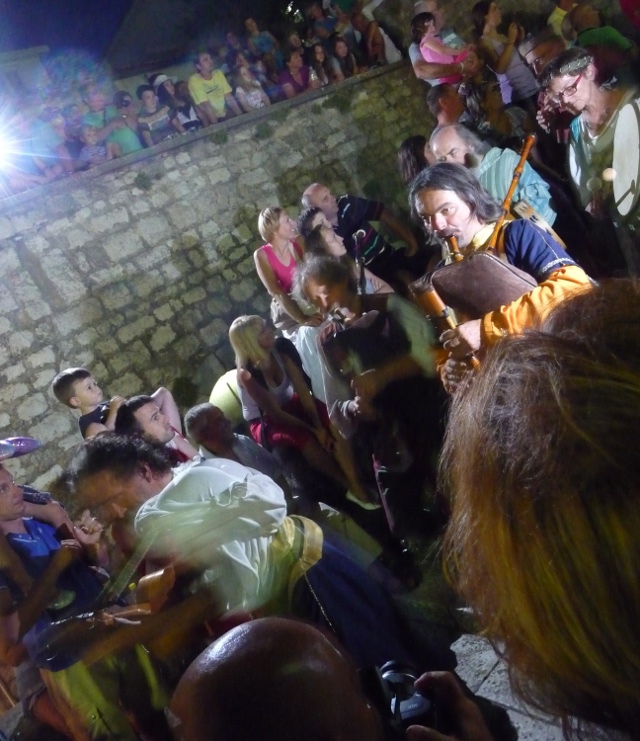 Standard bearers, musicians, soldiers in armour, troubadours, artisans in thick leather aprons, bowmen, women in bonnets with children – everybody. Several hundred of them, it seemed, as they all passed down and lined up in the square below. The ceremony was in full swing, now that the medieval townspeople were all present.
Standard bearers, musicians, soldiers in armour, troubadours, artisans in thick leather aprons, bowmen, women in bonnets with children – everybody. Several hundred of them, it seemed, as they all passed down and lined up in the square below. The ceremony was in full swing, now that the medieval townspeople were all present.
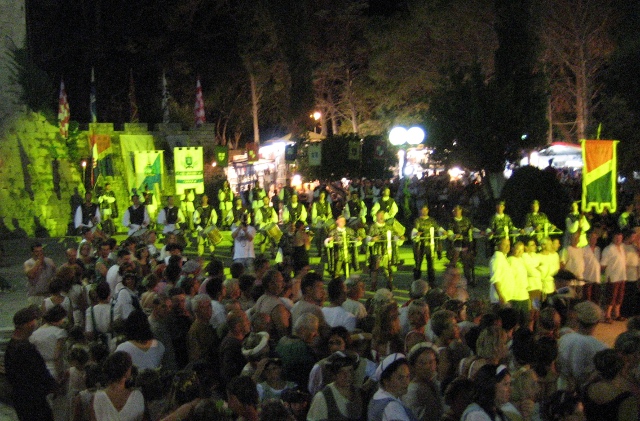 For the next hour or so, we watched as various groups demonstrated their skills. A men’s choir was followed by a duel with longswords, and the town standard was raised on a flagpole. Then, the stage cleared and there was silence. A small flame was spotted up on the highest tower of the city wall… and BADOOOOOM. A cannon was fired, so loud that it wasn’t heard so much as felt deep inside. Strings of fireworks burned from the tower battlements, and it was over. The fair was open.
For the next hour or so, we watched as various groups demonstrated their skills. A men’s choir was followed by a duel with longswords, and the town standard was raised on a flagpole. Then, the stage cleared and there was silence. A small flame was spotted up on the highest tower of the city wall… and BADOOOOOM. A cannon was fired, so loud that it wasn’t heard so much as felt deep inside. Strings of fireworks burned from the tower battlements, and it was over. The fair was open.
We wandered back along the upper street of the town, to find that all the stalls we’d found half-assembled were open for business. From ironmongery to embroidered lavender pouches to wood carving to ceramic work, with plenty of traditional food and drink available for good measure.
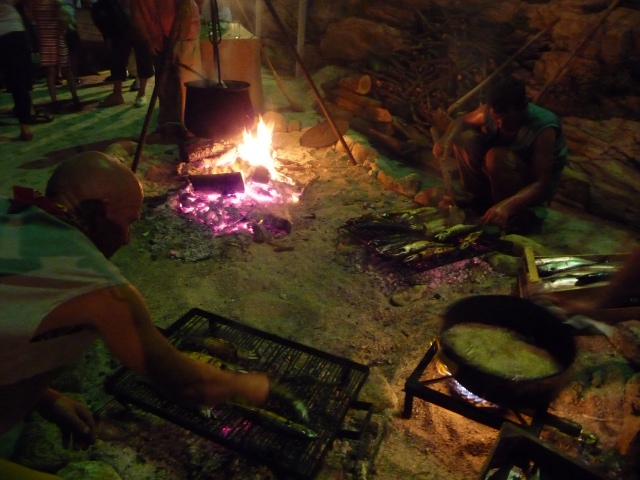 From one square, as a group of drunken lepers were being interviewed by the TV news, we peered down to the sea-front walkway below – to find fish grilling on open fires, next to an old boy building a small wooden boat, next to small children doing the laundry with large wooden paddles, next to other children playing a game with stones on a linen board or selling their mother’s herbal remedies.
From one square, as a group of drunken lepers were being interviewed by the TV news, we peered down to the sea-front walkway below – to find fish grilling on open fires, next to an old boy building a small wooden boat, next to small children doing the laundry with large wooden paddles, next to other children playing a game with stones on a linen board or selling their mother’s herbal remedies.
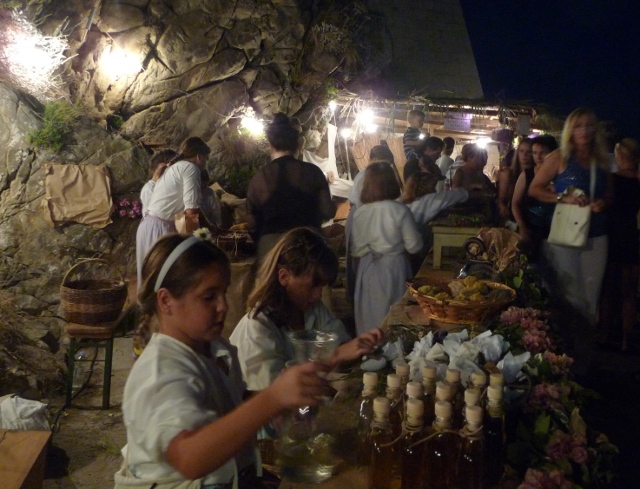 A group of troubadours juggled fire, then spun a wheel of blazing torches around wildly, as we recognised them as near-neighbours at the campsite.
A group of troubadours juggled fire, then spun a wheel of blazing torches around wildly, as we recognised them as near-neighbours at the campsite.
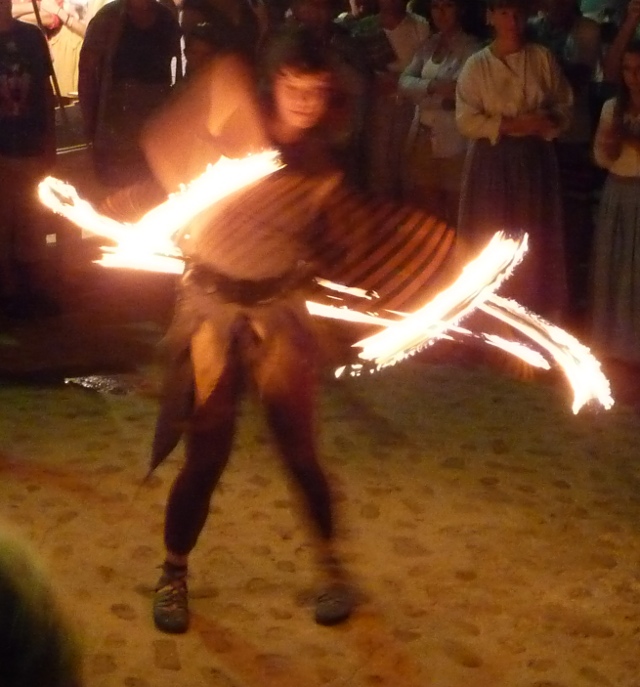 We wandered, we ate, we drank. We started to feel a little weary, and suddenly realised it was half past midnight – yet it was all still going strong. Time for one of those taxi-boats back to bed.
We wandered, we ate, we drank. We started to feel a little weary, and suddenly realised it was half past midnight – yet it was all still going strong. Time for one of those taxi-boats back to bed.
We’d been planning to only spend one night at Rab, but the fair was too compelling. So, after a slow day at the campsite, we headed back in time once again. Fish (large and small), squid, a thick slab of fried dough with cured ham – all washed down with local red wine.
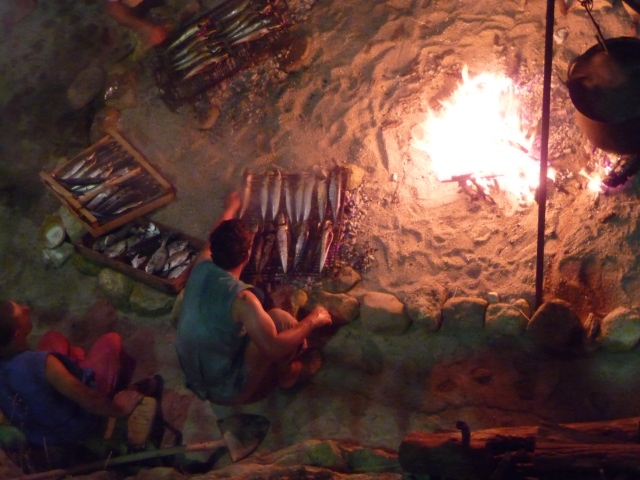 A wooden boat was rowed around the harbour with a burning fire in a grill jutting above the prow, as another boat slowly cruised around with somebody stood in the bow searching for fish to spear, as Grandad remained on dry land mending nets.
A wooden boat was rowed around the harbour with a burning fire in a grill jutting above the prow, as another boat slowly cruised around with somebody stood in the bow searching for fish to spear, as Grandad remained on dry land mending nets.
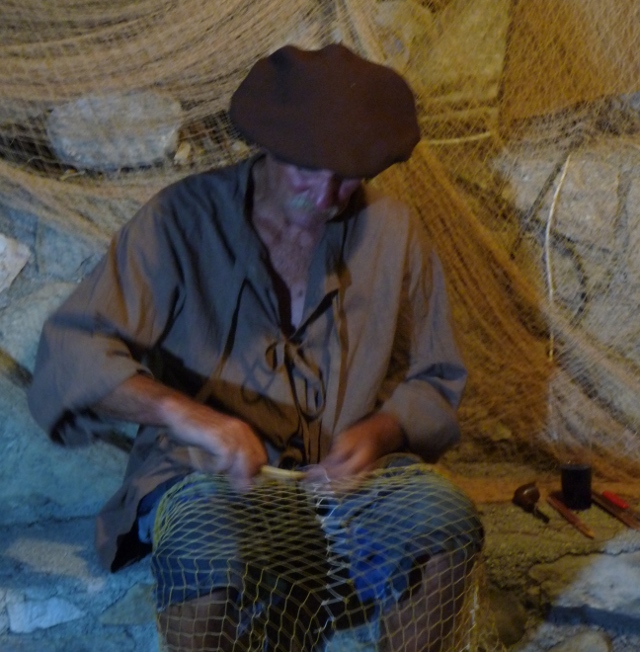 A third night tempted, especially with the closing fireworks on the bay at midnight, but we resisted – time to move on, and see the rest of the island. Once we’d evicted a small grey kitten from the van. The north of the island’s reputed to have some of the best sandy beaches in the country (they’re in short supply – most seafront is rock or shingle), but the lines of traffic heading through the drab sprawling concrete mess of Lopar towards the beach carparks were not inspiring. Instead, we joined the queue for the next ferry, on to Krk. Had the island lived up to that claim? Difficult to say. It’s beautiful, certainly, but they all have been – and, for us, the memories won’t be of the scenery.
A third night tempted, especially with the closing fireworks on the bay at midnight, but we resisted – time to move on, and see the rest of the island. Once we’d evicted a small grey kitten from the van. The north of the island’s reputed to have some of the best sandy beaches in the country (they’re in short supply – most seafront is rock or shingle), but the lines of traffic heading through the drab sprawling concrete mess of Lopar towards the beach carparks were not inspiring. Instead, we joined the queue for the next ferry, on to Krk. Had the island lived up to that claim? Difficult to say. It’s beautiful, certainly, but they all have been – and, for us, the memories won’t be of the scenery.

